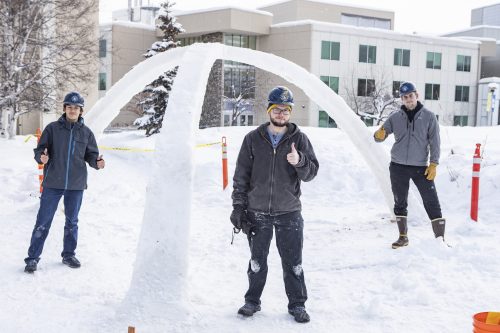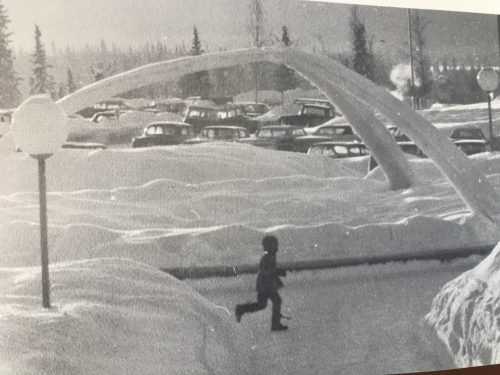UAF student engineers look to past for ice arch inspiration
March 22, 2021
Jeff Richardson
907-474-6284

One of the quirkier traditions at the University of Alaska Fairbanks looked like it might be in jeopardy this year, as pandemic protocols forced the cancellation of events and gatherings throughout 2020.
For more than half a century, engineering students have created towering ice arches in UAF’s Cornerstone Plaza as a way to break up the late-winter doldrums. The process has become both a social event and a showcase for their emerging design and construction skills.
But with many classes and events happening remotely because of COVID precautions this year, efforts to plan a new arch design were starting to feel a bit too complicated.
“We don’t have as many people together, and it’s just hard to make things happen,” said Bill Schnabel, the dean of UAF’s College of Engineering and Mines. “But I want our students to know that even in adversity we build, we get it done.”
The solution, it turns out, required looking into the past. Instead of starting from scratch, students decided to borrow an old design and pay tribute to the original arch, which was built in 1966.
That design, by engineering students Alan Straub and Mark Fryer, was a sight to behold — a monstrous three-legged structure that was 40 feet wide and 15 feet tall. It made such an impact that it launched an annual UAF ritual.
“I thought it was kind of nuts,” said Zach Miller, a civil engineering student who led this year’s construction project. “It looked fragile — you could see the legs were wide but fairly thin — but it was kind of fun.”

The design was inspired by a visit to Europe that Straub and his wife had taken in 1965. The soaring architecture he saw everywhere became the model for the distinctive arch he would build in Fairbanks later that winter.
Straub and Fryer, with help from other students, built the massive structure by packing a slushy mix of snow and water into forms and letting it freeze solid.
To test its strength, they dangled a few hundred pounds of sandbags from the arch. They even recruited Carla Sullivan, a reporter for the university newspaper and the reigning Miss Alaska, to sit on a swing and do the same. Her photo and story about the experience appeared on the front page of the Polar Star.
“We had no help from professors, there was no safety oversight, and it was entirely student-led,” said Straub, who now lives in California, in a phone interview. He said they liked it that way, offering the freedom to try something new, assess the risks and learn from their mistakes.
For Straub, the eye-catching ice arch was a modest early accomplishment in a busy and successful engineering career. After graduating from UAF, Straub’s projects included Aloha Stadium in Honolulu, the tanker docks in Valdez and the Auburn Bridge in California, which towers more than 700 feet above the North Fork American River.
The 2021 version of the arch needed to be scaled back a bit, but not just because of modern safety regulations. As Fairbanks winters have gradually warmed, ice arch designs have changed to survive those higher temperatures. Miller decided to build a half-scale replica of the original project, which allowed the slush-packed forms to freeze quicker.
“I was talking to Alan Straub, and, when they were making it, they were having problems because it wasn’t cold enough, even though it was 30 below,” Miller said. “That’s funny, because it was plenty cold enough for us, and it was just 10 degrees.”
A group of about eight volunteers — students from engineering and other disciplines — pieced it together in three days. “It was a little stressful at the beginning, but it was satisfying at the end,” Miller said.
Schnabel, who studied at UAF from 1996 to 2000 before working as an engineering professor and administrator, said both ice arch projects are great examples of the university’s tradition of letting students discover on their own.
“During my time as a student, what I learned is that at UAF much of the learning is student-driven,” Schnabel said. “We have the agency to go out and do things on our own. The ice arch is a different thing this year, but it’s still about engineering students overcoming obstacles and making things happen.”


